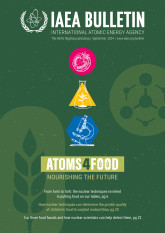
If you would like to learn more about the IAEA’s work, sign up for our weekly updates containing our most important news, multimedia and more.
Climate-Smart Agriculture in Kenya Feeds More People
Katy Laffan

Agriculturalists across Kenya, such as this Maasai banana farmer from Rombo, are benefitting from nuclear and isotopic techniques to improve the management of water and other resources. (Photo: K. Laffan/IAEA)
(This article was originally published in the September 2024 IAEA Bulletin)
Scientists in Kenya are using nuclear science to help farmers modernize their planting practices amid changing climate patterns.
“Kenya, like many African countries, is struggling to grow the crops it needs in the face of climate change. There is no one perfect solution,” explains Shaukat Abdulrazak, Director for the Division for Africa at the IAEA’s Department of Technical Cooperation. “But nuclear techniques are helping to give Kenyan scientists and farmers the precise information and tools needed to squeeze every drop of water and every inch of growth out of this beautiful land.”
The work begins in the laboratory, where scientists — many of them trained or supported by the IAEA and the Food and Agriculture Organization (FAO) — strive to identify the best planting and watering techniques that can be adopted by farmers in water-scarce conditions.
Using nuclear and isotopic techniques, the scientists can track carbon, water and nutrients as they move through soil and crops to test the success of different water and soil management approaches.
“Nuclear science helps farmers adapt to climate change. The IAEA and the FAO are working with scientists in Kenya and around the world to increase crop yields, protect water sources and feed more people,” says Najat Mokhtar, Head of the IAEA Department of Nuclear Sciences and Applications.
“ Despite poor soil fertility and water scarcity, these techniques have already helped thousands of farmers in Kenya increase their crop yields by 20 per cent and save 20 per cent in fertilizer costs.
A better understanding of crops
For example, at the Kenya Agricultural and Livestock Research Organisation (KALRO) in Nairobi, soil and water scientists run a laboratory that has its own prototype farm, with training and equipment support provided by the IAEA.
Jane Akoth, a PhD candidate at KALRO, is one of the next generation of scientists learning nuclear skills for farming. “We are using nuclear techniques to evaluate different plant technologies that can be adopted by different farmers,” she explains.
To investigate how different plants respond to different watering and fertilizing conditions, the scientists test the success of techniques such as drip irrigation, which uses considerably less water than traditional irrigation techniques.
From lab to farm
Once the scientists have determined the best approaches for each crop, they share that information directly with farming communities. This leads to a shift in the management of agricultural resources that results in a more productive and resilient agriculture.
KALRO’s Dr Kizito Kwena works closely with hundreds of ‘farmer field schools’ around the region, where cooperatives of small scale farmers come together to cultivate shared pieces of land and learn these climate-smart techniques that they can take back to their own plots.
“Despite poor soil fertility and water scarcity, these techniques have already helped thousands of farmers in Kenya increase their crop yields by 20 per cent and save 20 per cent in fertilizer costs,” says Dr Kwena.
“The use of moisture metres is very important, because they tell farmers when to irrigate and when not to, helping them to manage the little water that they have very well,” he added.
Eunice Francis, a farmer who attends a field school in Machakos, said the novel approaches had already helped her to grow more food to feed her family. “Since I started farming with these technologies, I have improved crop yields and the water use is much better.”
_______________________________________________________________________________________________
The IAEA and the FAO work together to strengthen countries’ capacities to use nuclear and isotopic techniques to improve agricultural resilience and adapt to climate change.





